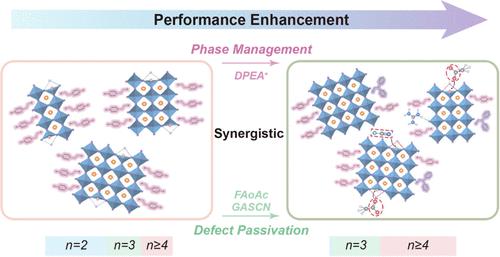Manipulating Phase and Defect Distribution of Quasi-2D Perovskites via a Synergistic Strategy for Enhancing the Performance of Blue Light-Emitting Diodes
IF 8.2
2区 材料科学
Q1 MATERIALS SCIENCE, MULTIDISCIPLINARY
引用次数: 0
Abstract
Quasi-two-dimensional (quasi-2D) mixed-halide perovskites are a requisite for their applications in highly efficient blue perovskite light-emitting diodes (PeLEDs) owing to their strong quantum confinement effect and high exciton binding energy. The pace of quasi-2D blue PeLEDs is hindered primarily by two factors: challenges in precisely managing the phase distribution and defect-mediated nonradiative recombination losses. Herein, we utilize 2,2-diphenylethylamine (DPEA+) with bulky steric hindrance to disturb the assembly process of a slender spacer host cation, 4-fluorophenylethylammonium (p-F-PEA+), enhancing phase distribution management in quasi-2D PeLEDs. The DPEA+ not only inhibits the small-n phase but also strengthens carrier transport and alleviates exciton quenching. In addition, dual additives─formamidine acetate (FAoAc) and guanidine thiocyanate (GASCN)─were incorporated to assist phase tailoring and passivation of remaining defects in the perovskite films. The C═O and SCN– groups can coordinate with Pb2+ to suppress the charge trap density and nonradiative recombination. As a result of employing a synergetic strategy for comprehensive phase distribution regulation and defect passivation, the optimized device achieves blue emission at 479 nm with a 5× improvement in external quantum efficiency (EQE) and a 13× increase in device operating stability. This synergetic strategy paves a simple route for phase management and defect passivation toward high-performance blue-emission PeLEDs.

通过协同策略控制准二维钙钛矿的相位和缺陷分布以提高蓝色发光二极管的性能
准二维(准二维)混合卤化物钙钛矿由于其强量子约束效应和高激子结合能而成为高效蓝光钙钛矿发光二极管(PeLEDs)的必要条件。准二维蓝色等离子体发光二极管的发展速度主要受到两个因素的阻碍:相位分布的精确管理和缺陷介导的非辐射重组损失。在此,我们利用具有大空间位阻的2,2-二苯乙胺(DPEA+)来干扰细长间隔载体阳离子4-氟苯乙胺(p-F-PEA+)的组装过程,增强准二维pled中的相分布管理。DPEA+不仅抑制了小n相,还增强了载流子输运,减轻了激子猝灭。此外,加入双添加剂──醋酸甲脒(FAoAc)和胍硫氰酸酯(GASCN)──有助于钙钛矿薄膜中剩余缺陷的相剪裁和钝化。C = O和SCN -基团可以与Pb2+配合抑制电荷阱密度和非辐射复合。由于采用了相位分布综合调节和缺陷钝化的协同策略,优化后的器件在479 nm处实现了蓝色发射,外量子效率(EQE)提高了5倍,器件工作稳定性提高了13倍。这种协同策略为实现高性能蓝光发光二极管的相位管理和缺陷钝化铺平了一条简单的途径。
本文章由计算机程序翻译,如有差异,请以英文原文为准。
求助全文
约1分钟内获得全文
求助全文
来源期刊

ACS Applied Materials & Interfaces
工程技术-材料科学:综合
CiteScore
16.00
自引率
6.30%
发文量
4978
审稿时长
1.8 months
期刊介绍:
ACS Applied Materials & Interfaces is a leading interdisciplinary journal that brings together chemists, engineers, physicists, and biologists to explore the development and utilization of newly-discovered materials and interfacial processes for specific applications. Our journal has experienced remarkable growth since its establishment in 2009, both in terms of the number of articles published and the impact of the research showcased. We are proud to foster a truly global community, with the majority of published articles originating from outside the United States, reflecting the rapid growth of applied research worldwide.
 求助内容:
求助内容: 应助结果提醒方式:
应助结果提醒方式:


